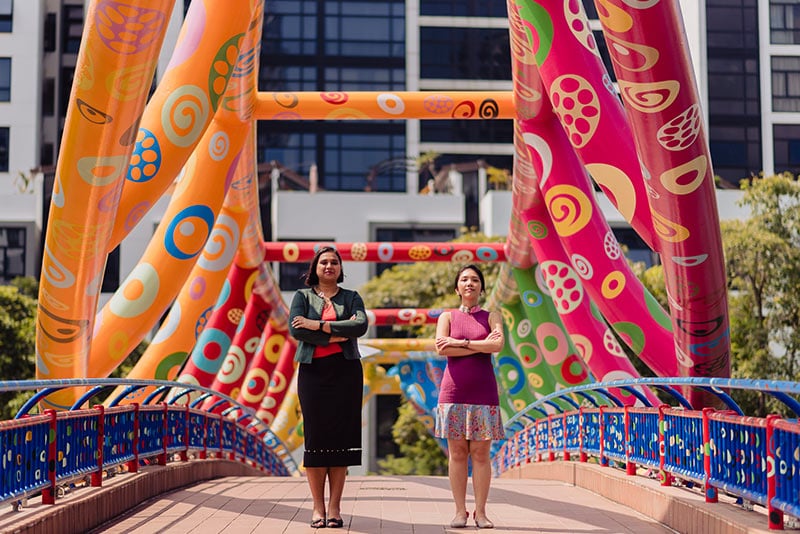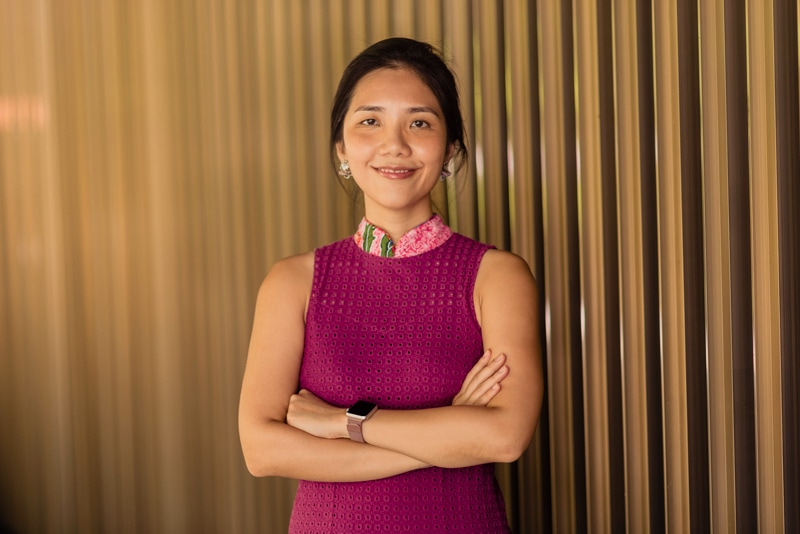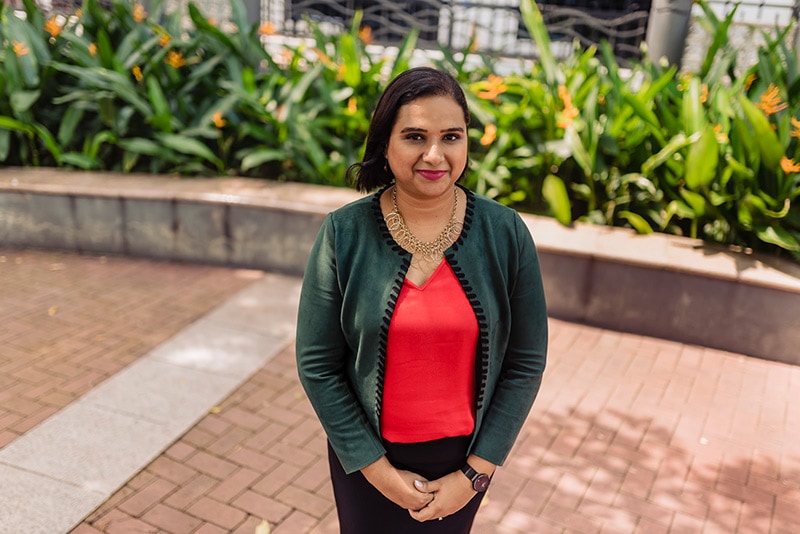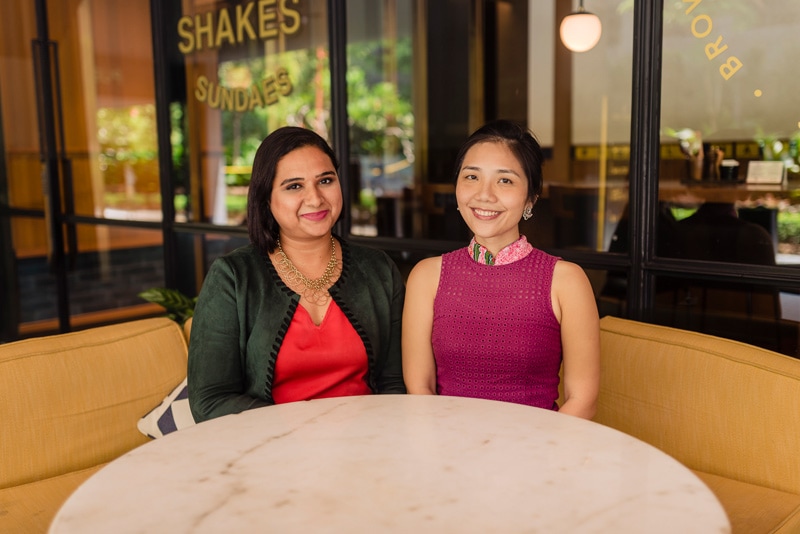Meet Shiok Meats – The World’s First Start-Up To Grow Shrimp From Stem Cells
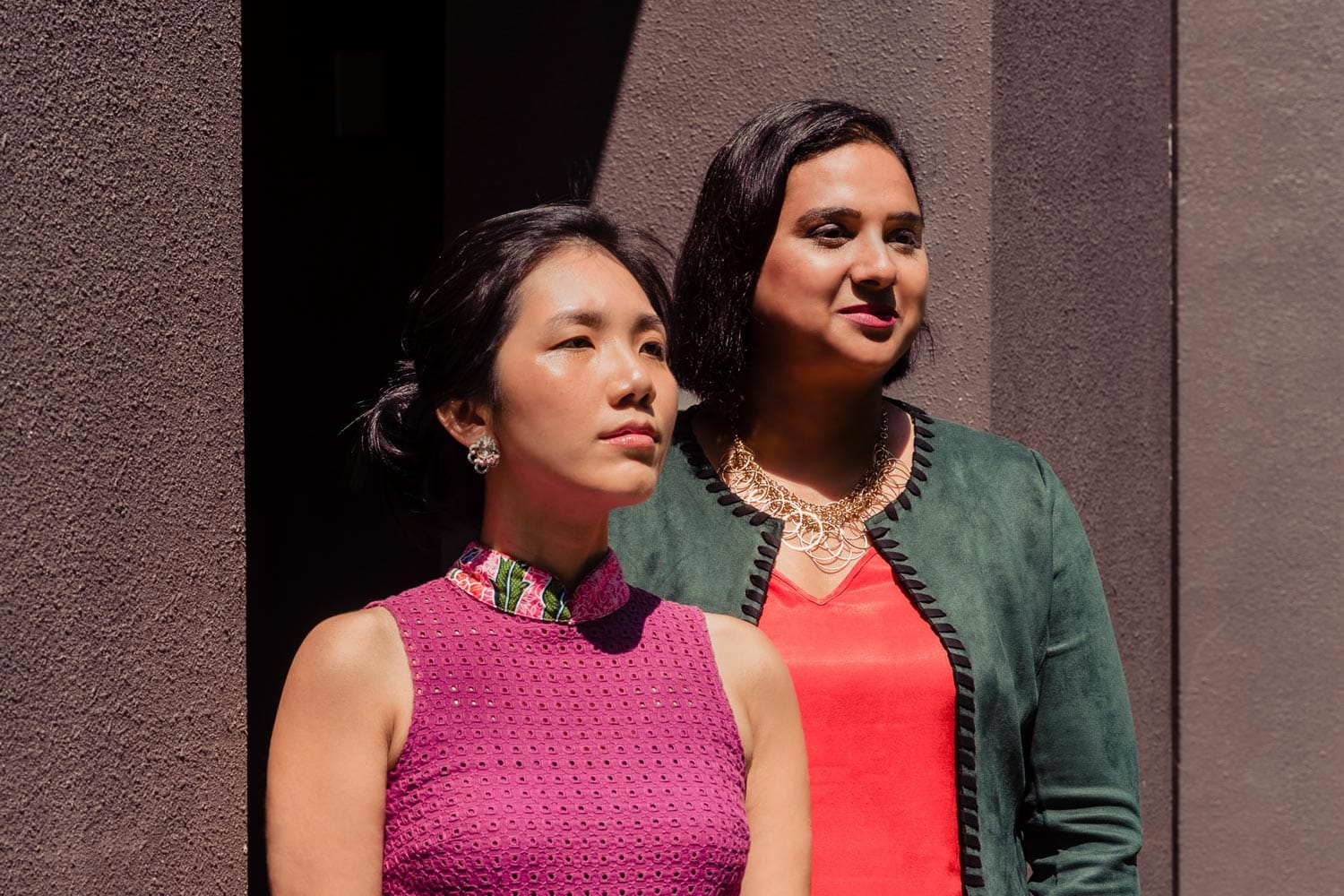
In the midst of a worldwide sustainability high, following the hype of Impossible Foods’ plant-based ground beef, seafood has been relegated to the backburner. In fact, when it comes to eating clean, our first MO is to cut out red meat and poultry—limiting ourselves to seafood as our main source of protein and becoming pescatarians. It’s practically unheard of to do it the other way around—no fish, only beef, pork and chicken. Perhaps this is due to the fact that we live closer to mammalian creatures, whose DNA also resembles ours more so than aquatic animals. We’ve seen gory documentaries of chickens getting debeaked, ducks being force-fed, and crying cows undergoing electrocution, before ending up on our plates. But what about fish, shrimps and lobsters? The seafood industry is, in fact, plagued with a host of problems. Thanks to water pollution and the widespread use of plastic, schools of fish are swallowing up our non-biodegradable waste, which leads to microplastic ending up in their bodies and potentially in ours too. The prawn on your plate might’ve come from the sewage canal as well, in a Bloomberg report. Grown by dodgy farmers looking to skimp on costs, these substandard shrimps are washed with antibiotics before being sold at wet markets in Asia. Feeling queasy, yet? Here’s another vile statistic: There are prawn trawlers who employ the “catch-all” technique, fishing as much as 20 kg of marine life to collect 1 kg of prawns, and leaving the rest to die. Imagine the rotten luck of a sea turtle finding itself trapped in one of these nets, unable to escape its fate as collateral damage. Enter Shiok Meats, a local start-up that recreates genuine shrimp meat from stem cells. Founded in 2018 by stem cell biologists Dr Sandhya Sriram and Dr Ka Yi Ling, the young company has already made massive leaps in less than a year, showcasing siew mai made from cell-based shrimps at the Disruption in Food and Sustainability Summit. The first in the world to produce shrimp alternatives, the two-woman operation started with $10,000 and has now grown to raise $4.6 million in its latest seed funding round. Don’t mistake it as the prawn version of Impossible Foods and Beyond Meat though. “We’re making exactly the same thing. The only difference is the process. It’s like making an IVF baby. Just because I made it in a dish doesn’t make it not a baby. I’m just making the process more efficient,” says Ka Yi. What comes out of the process is minced meat that tastes just like a regular prawn. Safe to say, no animals are harmed. Currently renovating their office and working towards scaling up and lowering costs from $5,000 to $50 per kg, the duo speak about the genesis of Shiok Meats, their revolutionary technology, and the little-known dark underbelly of the seafood industry.
ANGELA LOW: How did you meet each other?
SANDHYA SRIRAM: We knew each other when we were working at A*STAR. She was a scientist. I was just quitting being a scientist and becoming a business development manager. I think we met at an event.
KA YI LING: Yeah, a networking event for the PostDoc Society at A*STAR. She was sharing her experience of going from being a scientist to a business development manager, and running her two start-ups. That was almost four or five years ago. We also met over the years at other networking events that she organised.
ANGELA: What were the two start-ups?
SANDHYA: The first one is a science news website called Biotech In Asia. I stopped running it in 2016. I’m still a shareholder. The second one is SciGlo, which is an education and event management company. I still run it in the sense that I don’t do the daily, hands-on work—my team does it—but I’m still there. Both of these start-ups were set up and run on a part-time basis.
ANGELA: Interesting. What was the process like, creating this cell-based shrimp alternative?
SANDHYA: When we started this company in August last year, it was an idea in our heads. There was no previous research about shrimp stem cells. Stem cell biology is done for human therapy, for curing diseases. A shrimp is nowhere close to a human being or a mammal. That’s why most of the stem cells that have been extracted in the past were either from a mammal or bird. Those animals are closer to human morphology.
The first step we took was to go into a lab, cut open a couple of shrimps and figure out how to take stem cells from them. Our first angel investor gave us $10,000, which we used to rent a lab in St. John’s Island. We’re both stem cell biologists so we were both pretty confident that if we can take stem cells from mammals, we could do the same with marine animals. It took us about two months to polish the protocols and we filed for our patent in January this year. Pretty fast if you think about it.
ANGELA: How does your technology work?
KA YI: For all cell-based meats, it starts with identifying and taking out stem cells from the animal, mostly muscle and fat. If you’re creating mammalian beef and pork, you might need blood vessels, skin and all that. If you’re creating prawn, crab and lobster meat, it’s just muscle and fat. You isolate, take out the stem cells from the live animal, and provide them with the nutrients they need in the form of a nutrient liquid called culture media, so they can grow. It contains digested protein, fats and sugars—digested because little cells don’t have digestive systems to help them process the nutrients.
You grow them in giant tanks like you would in a brewery. That gives you stem cells. But we don’t want to eat stem cells, so we have to change the type of nutrients we provide them, and make them into muscle fibres and incorporate them with fat, depending on what final product you want. The easiest and first product we made was a minced shrimp dumpling, siew mai. Most people do hamburger patties or sausages because mince is what we immediately get.
ANGELA: So when it comes out, it’s already minced?
SANDHYA: It’s like a meat slurry.
KA YI: Yeah. It’s great because we don’t need to de-shell it, or chop it up. It’s also flexible to use in a lot of dishes. But at the same time, it’s not usually a high-priced product. We’re working on creating the high-end version, which requires tissue engineering skills, so you’ll get the C shape of the shrimp and the texture. I don’t want to create the shell, but at least the meat.
ANGELA: How long does it take to create a batch?
SANDHYA: About four to six weeks from stem cell to meat.
ANGELA: How much does it cost?
SANDHYA: Right now, it costs us about $5,000 to $7,000 for a kilogram. That’s because the culture media we grow the cells in can only be purchased from pharma companies, and they’re pretty expensive. The price will come down once we figure out an in-house culture broth that we can grow the cells in. This will be mostly made from plant ingredients, so it’s cheaper and still edible. We want to bring the cost down in the next 12 months to about $50 to $60 a kilogram, which is more affordable to people.
ANGELA: What’s the market price right now?
SANDHYA: The market price for a kilogram of frozen shrimp is about $30 to $40. We want to enter the market as a premium product because it’s a novel, high-tech food product. We’ll be a premium product for a while, before we go into mass production and further reduce our cost.
ANGELA: What’s the nutritional content of your product?
SANDHYA: In theory, the nutritional content should be the same. We personally haven’t done the tests yet. We’re in the midst of doing that.
KA YI: We’re making exactly the same thing. The only difference is the process. It’s like making an IVF baby. Just because I made it in a dish doesn’t make it not a baby. I’m just making the process more efficient. Right now, we’re only producing meat. We’re not doing shells, heads or eyes. I personally don’t eat them. There might be people who do, but most of the nutrients come from the meat itself. At the bottom level, it’s all cells. They’re little Lego blocks. We’re just producing the Lego blocks in a brewing tank, instead of inside an animal.
ANGELA: Would it be considered highly processed?
SANDHYA: Actually, no. We don’t add flavourings or any foreign ingredients. We keep it as natural as it is. Imagine growing the meat outside of the animal body, in a controlled environment. It’s cleaner. It’s definitely healthier. We don’t use antibiotics or synthetics. At the same time, we don’t kill animals. I think, regulation-wise, they might put it under processed foods because it’s made in a manufacturing facility. It’s not natural. But having said that, it’s preservative-free at least, at this point.
KA YI: I eat a lot of snacks like prawn chips. The only prawn in there makes up about 1% of the product. Everything else isn’t actually prawn. That’s what a processed food is. For ours, it’s all prawn.
ANGELA: Do you have plans to re-create the whole prawn?
KA YI: I don’t see a point in doing that. I think the eyes don’t offer you a lot of nutrients and the shell is actually what a lot of people dislike and have a hard time removing.
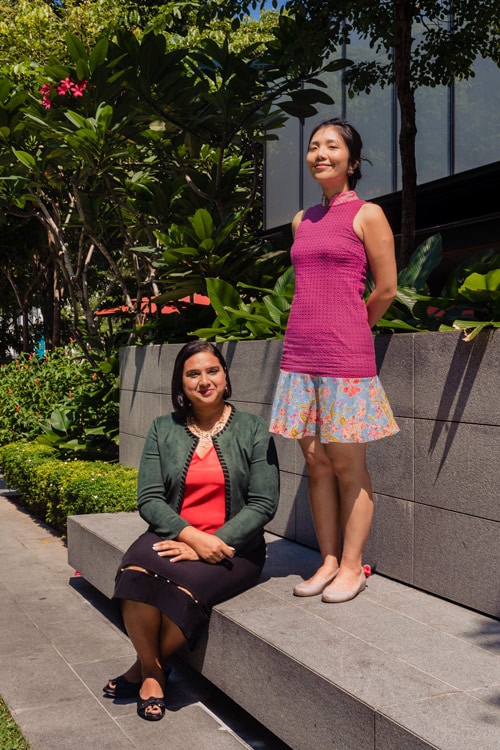
"We’re producing another form of protein, another level of seafood that people can consume. The idea is to supplement the existing shrimp industry, before replacing the industry."
ANGELA: Who do you consider your competitors right now, in terms of creating high-tech seafood substitutes?
SANDHYA: There are four companies, three in the US, one in Hong Kong, that are working on cell-based seafood, but they’re all doing fish—tuna, salmon and fish maw. I don’t think we’re competing. I think all of us want to collaborate and share our knowledge, since the industry is very small, and all of us are working towards a common goal. Besides, if we’re working on crustaceans, we’re not going to move to tuna tomorrow. If we do tuna or some other fish, it would probably be five years down the line.
KA YI: Even within crustaceans, there are so many that I’d be amazed if I can cover even five or 10 of them. Until we get one into the market, get through the technology and the regulations, and see that there’s market interest, there’s no point having a huge portfolio of hundreds of different types of seafood.
SANDHYA: We want to do crabs and lobsters too, but maybe in the next couple of months. Our first product will definitely be shrimp.
ANGELA: Since it’s not plant-based, would it be considered a meat substitute?
SANDHYA: It’s not a meat substitute. It’s an alternative protein, in the sense that what we’re doing currently is to disrupt the entire fishing and prawning industry. We’re producing another form of protein, another level of seafood that people can consume. The idea is to supplement the existing shrimp industry, before replacing the industry.
KA YI: Meat substitutes mainly refer to things that are not meat, although they also fall under alternative protein. A lot of people ask us if it’s the prawn version of Impossible Foods or Beyond Meat. It’s not. It’s real prawn.
ANGELA: I think people are more aware of the dark side of the red meat industry than that of the prawn industry. Can you shed some light on that?
SANDHYA: A lot of people don’t understand much about the shrimp industry. Bloomberg broke a story a couple of years ago on the Chinese and Vietnamese shrimp market. Most of the shrimps that are grown in farms are actually grown in sewage water, the reason being that shrimps are bottom feeders. In the ocean, they’re at the bottom, feeding on other dead animals and plants. The shrimp farmers exploit this, so they don’t have to spend money on clean water and feed.
If you go to the Mekong Delta, you can see shrimps growing in the sewage canals. That’s where they fish. If you go to a wet market in the Mekong Delta in the morning, you’ll see people taking shrimp from the sewage canal and cleaning them with antibiotics before selling them. I’ve seen it first hand in Thailand, three, four years ago. I’m a vegetarian by choice, and having seen that, I would never eat a shrimp in my life.
KA YI: And they don’t label them as washed with antibiotics. It just looks like it’s water.
SANDHYA: The shrimp industry is extremely toxic to animals, human beings, and the environment because you’re letting antibiotics into the river and oceans. They also found out that in China each shrimp was individually injected with hormones to make them look bigger, because the bigger the shrimp, the better the price. Yet, the industry doesn’t get as much press coverage. If you talk about animal cruelty, you think of animals crying like how cows have tears in their eyes before they get slaughtered. Shrimps can’t really cry, but I’m sure they are.
KA YI: With farming, they also clear out the mangroves, which leads to a lot of weather disasters. The shrimp industry is also very unstable. The prices fluctuate a lot because they’re always infected with diseases. When it comes to fishing, the ocean is not limitless either. And the more you fish, the more you’re not allowing the natural animals to recuperate and grow to the right size. There’s also a report that said that for every kilogram of prawns fished from the ocean, 20 kilograms of other sea creatures like sea turtles get caught, and they just die.
ANGELA: Ka Yi, you’re not a vegetarian right?
KA YI: I’m not. I’d call myself a flexitarian. When I eat on my own, I don’t really eat meat. But when I go out with friends, it’s not very economical to eat vegetarian. I love to eat meat and seafood sometimes. If you eat sashimi in Japan, it’s awesome. You can’t eat it every day, but if you want to keep eating it, you must find a way to do it in a way that doesn’t harm yourself or the environment.
ANGELA: Have you always been conscious of your food choices?
SANDHYA: To an extent, but it’s kind of impossible especially in Singapore because most of the food is imported. If you go to a restaurant and ask them where the broccoli is from, how they’re grown, if they’re pesticide free, they’ll just look at you and go, “Huh? What? Why are you asking these questions?” It’s the same problem with meat. They don’t even know if it’s wild-caught or farmed.
KA YI: When I was studying in Wisconsin, which is a farming state, I would go to the farmer’s market with my husband every week and buy vegetables and meat. They’re from very small farms, so all of them know their animals and care about them. There are a few sustainable restaurants here that care about where the food comes from, but that’s very, very rare. And it’s very hard. It’s kind of awkward to keep asking where the prawns or red meat come from.
ANGELA: Besides food, how else do you practise sustainability and mindfulness?
SANDHYA: Even though we work in the lab and use a lot of disposables, we try to minimise our plastic use. To maintain sterility and make sure the quality of the products is great, we still have to use disposables, but we’re conscious about how much we’re using. In my personal life, I don’t carry plastic bags. I don’t use leather. I don’t wear clothes that come from an animal. We believe in the concept of tote bags.
KA YI: You should bring your own box, and pack your own food too. A lot of people don’t finish their food and it’s a waste. I always pack what I don’t finish, and I bring my own straws. There are also some good eco stores, where you can buy stuff like nuts and grains in bulk. Even for detergent and shampoo, there are some small shops with good brands that contain less chemicals and are friendlier to people with sensitive skin. You can just buy what you need. If you buy a whole bottle and end up not liking the product, you can’t give it away or return it. When we were in Australia, my husband and I used to go to The Source, which is now in Singapore.
ANGELA: How big is Shiok Meats right now?
SANDHYA: We have six people now. We’ll grow to about nine in the next couple of months. A vision that we both share is that we want to run a lean company.
ANGELA: Was there any hesitation when you decided to embark on Shiok Meats?
SANDHYA: I was ready to go full-time from the start. I had already decided to quit my job. I was looking for a full-time CTO to join me, and I was speaking to a couple of people including Ka Yi, who was looking to exit academia. Even though we’ve known each other for four years, we were never close friends. We probably never chatted beyond, “Hi, how’s work?”
KA YI: Well, we did an interview together.
SANDHYA: Yeah, but we didn’t really know each other personally. We had a long chat, and we just fit. It’s her first time running a start-up, so I assured her of certain things, and told her that we couldn’t take salaries for a couple of months. She was okay with that. I said, “Let’s give ourselves 12 months. If we can’t do anything in 12 months, can’t figure out the technology, and nothing’s moving forward, we’ll quit this idea and go back to a job.”
KA YI: I never thought I would join a start-up, even as an employee. Since I was in JC, I knew I wanted to do research. But I’m not a typical research scientist. I don’t have a resume that says I went to NUS and NTU, and my work has been published in a high-end journal. My thing has always been doing the hands-on stuff. But that’s not good enough to get me anywhere teaching in a university or being a research group leader. I never really found anything that I connected with, until I talked to Sandhya.
At that time, I was looking for something where I could do research, while learning more. Staying in academia in Singapore is quite limited. I kind of knew about cell-based meats, but never really looked into them. As we talked more, I realised this was something I really wanted to do. Of course, I was a bit hesitant to join a start-up. I was very honest about not having any experience working in start-ups, and not being sure if I can deal with rapid changes and stress. But Sandhya was so open, and I knew I was going to learn so much from her.
SANDHYA: If co-founders don’t have an amicable relationship, the business will suffer. Co-founders should also be willing to compromise at the right places. There’ll always be a difference in opinion between people. It’s a good thing because you need someone who can challenge your thought process and make you think more.
KA YI: We respect each other’s work-life balance as well. We don’t want anybody to be overworked because you’ll burn out really fast and that’s what we’ve both experienced before in previous positions. At the same time, as a small start-up, everyone must be willing to cover and help each other. You’re not just doing what your job description says.
"Our vision is in 10 years, if people buy shrimp, it should be Shiok shrimp. Nobody should even call it Shiok shrimp. They’ll just be buying shrimp at the supermarket."
ANGELA: What’s your working relationship like?
SANDHYA: We’re both working towards the same vision, the ultimate aim of the company, but our working styles and ways of thinking are different. We complement each other, and are both very open to communicating.
KA YI: On a day-to-day basis, she handles a lot of the external, big-picture aspects of the company, such as pitching, fund-raising, admin and finance, whereas I handle the scientific team and do hands-on work in the lab. We don’t exactly need to have similar working styles, as long as we understand each other. This is our first full-time start-up, managing so many people who are working with us. From the outset, we need to build the right culture so there won’t be any problems in the future. We recognise that there are things we don’t know, and we’re open about it with our team as well.
ANGELA: What’s your greatest achievement in life so far?
SANDHYA: I don’t think I’ve achieved it yet. Maybe the transition from being a scientist to an entrepreneur. It’s so personally satisfying. For me, it’s about providing jobs for people, providing a great work environment, and knowing what not to do—life has taught me that. I’ve already made my mistakes, and now I know better. But yeah, I love being an entrepreneur. I love hustling. It’s an addictive thing.
KA YI: For me, it would be starting a summer undergraduate research fellowship in Wisconsin. I did that in 2013 while doing my PhD. That was a graduate student group. Every year, they’ll onboard about four to five students. We pay the students, I think, $1,000 a month throughout summer. We take applications from undergraduates who want to do research, and grad students and postdocs who want to mentor students. We have a 12-week programme, where professors come to talk about how to do research posters and presentations.
The mentors go through a scientific mentorship programme, so they’ll learn to be actual mentors and not just have students as slaves. I’m very proud that it happened. A lot of students from the first few batches that I onboarded have gone on to grad school and into the industry to contribute to stem cell research. I ran it for two, three years, before passing it on to the next committee.
ANGELA: Have you always been passionate about science? If so, to what do you attribute your passion?
SANDHYA: For as long as I’ve known I was alive on this Earth, I wanted to be in science. I think I was five years old, and all I wanted was to be a doctor. I started watching medical shows at seven or eight. I was just so fascinated by the human body, and the fact that I was born from a human being. Even now, I’m fascinated that I actually gave birth to a human being. It’s the constant process of thinking, exploring, experimenting without knowing what’s on the other side that I love. I just love the unknown.
KA YI: When I was young, I was really into doing work attachments and internships. I tried being a lawyer and an architect. None of those stuck. Then, I did a research internship at A*STAR when I was in JC, and I was like, “This is it.” I knew biology was what I wanted to do when I learnt about Dolly the sheep, the cloned animal. I wanted to understand how to reset a very specialised cell, like a sperm and an egg and create an entire animal. I’m not using my work to understand that in particular, but we’re using similar principles with stem cells to make food.
ANGELA: You’ve been able to make siew mai from cell-based shrimp meat, which was showcased at this year’s Disruption in Food and Sustainability Summit. Is there any difference at all when it comes to flavour, between regular siew mai and your version of it?
KA YI: I love to eat siew mai. I was born in Hong Kong, so I have a deep-rooted love for dim sum and am picky about them. I felt that our siew mai tastes sweet, as in the seafood sweetness, rather than sugar sweetness. We told the chef not to add oyster sauce, or anything that has any animal in it, except for the shrimps. Everything else was made from vegetables.
ANGELA: I wonder if you’d be able to taste the difference between lab-grown shrimps and sewage shrimps.
KA YI: We haven’t done a side-by-side comparison.
SANDHYA: But we’ll probably do it soon.
KA YI: It will take us three to five years to reach a wide market and we’re aiming to be in one or two restaurants at the end of next year.
ANGELA: What’s next for you in terms of scaling up?
SANDHYA: We’re raising our next series of funding. That’ll be mostly for manufacturing, which is another beast on its own, setting up a huge industrial space, getting all the licences, getting a team of engineers, sales and marketing, and process management people. The first plant will be in Singapore.
ANGELA: A lot of tech companies innovating these ground-breaking meat substitutes say that they want to save the environment and get people to stop eating meat, but are people actually eating any differently?
SANDHYA: From the statistics and what we’ve seen, I think people are. It’s more of the millennial generation that actually bothers about what goes on their plates. The amount of questions and interest we’ve gotten for a company that hasn’t even put out a product… is overwhelming. We’re receiving 10 emails a day about something that isn’t even out in the market yet. At the end of the day, food should be your own medicine, but unfortunately, we’re eating pharma medicine for diseases that are caused by food. If you look at Chinese or Indian traditions, food was the remedy.
KA YI: More people are taking active choices to reduce the amount of meat they eat. Personally, I also do that, but honestly, I don’t want to become a vegan.
SANDHYA: And honestly, we don’t want all meat-eaters to become vegetarians. Then, we won’t have enough plants to feed them.
ANGELA: Is clean eating and living a sustainable life ultimately a luxury and privilege though?
SANDHYA: Now, it is. But I think that’s going to change over time when the cheaper, easily available ingredients aren’t available anymore because there’s nothing left to fish from the ocean. You have to go for a premium product. At the same time, we’re also thinking about what we can offer to the developing countries where people cannot afford it. How can we empower countries like India and Cambodia to use our technology to grow more shrimps? That’s why we’re patenting our technology and not keeping it a trade secret. Our vision is in 10 years, if people buy shrimp, it should be Shiok shrimp. Nobody should even call it Shiok shrimp. They’ll just be buying shrimp at the supermarket.
